An ideal gas is kept in two adjacent chambers of volume V and 2V, separated by a thin partition, under initial conditions as shown in figure. The chamber is adiabatic i.e., no heat flows in or out. Now the partition is removed and the gas is allowed to stabilize. If Pf and Tf are the values of final pressure and temperature, then :

Pf=53P
Pf=p
PfTf=89PT
Tf=32T
The correct Answer is:C, D
P1V1+P2V2=PfVf⇒2PV+2PV=Pf(3V)⇒Pf=4P3
n1=2PVRT&n2=2PVR(3T)⇒n1+n2=8PV3RT
PfVf=(n1+n2)R Tf⇒4P3(3V)=8PV3RT.(RTf)⇒Tf=3T2 ⇒ PfTf=8P9T
Similar Questions
A cylindrical container having nonconducting walls is partitioned in two equal parts such that the volume of the each parts is equal toV0. A movable nonconducting piston is kept between the two parts. Gas on left is slowly heated so that the gas on right is compressed upto volume V08. Find pressure and temperature on both sides if initial pressure and temperature, were P0andT0 respectively. Also find heat given by the heater to the gas. (number of moles in each part is n)
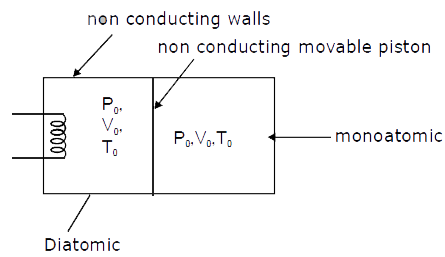 View Solution
View SolutionAn insulated cylindrical vessel is divided into three identical parts by two partitions 1 and 2. The left part contains O2 gas, the middle part has N2 and the third chamber has vacuum. The average molecular speed in oxygen chamber is V0 and that in nitrogen chamber is √87V0. Pressure of the gases in two chambers is same. Partition 1 is removed and the gases are allowed to mix. Now the stopper holding the partition 2 is removed and it slides to the right wall of the container, so that the mixture of gases occupy the entire volume of the container.
Find the average speed of O2 molecules now.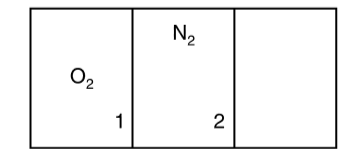 View Solution
View Solution
Knowledge Check
- Question 1 - Select One
An insulated container of gas has two chambers separated by an insulating partition. One of the chmabers has volume V1 and contains ideal gas at pressure P1 and temperature T1.The other chamber has volume V2 and contains ideal gas at pressure P2 and temperature T2. If the partition is removed without doing any work on the gas, the final equilibrium temperature of the gas in the container will be
A(T1T2P1V1+P2V2P1V1T2+P2V2T1BP1V1T1+P2V2T2P1V1+P2V2CP1V1T2+P2V2T1P1V1+P2V2DT1T2(P1V1+P2V2)P1V1T1+P2V2T2 - Question 2 - Select One
The variation of pressure P with volume V for an ideal diatomic gas is parabolic as shown in the figure. The molar specific heat of the gas during this process is
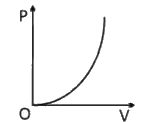 A9R5B17R6C3R4D8R5
A9R5B17R6C3R4D8R5 - Question 3 - Select One
An insulated container of gas has two chambers separated by an insulating partition. One of the chambers has volume V1 and contains ideal gas at pressure P1 and temperature T1. The other chambers has volume V2 and contains ideal gas at pressure P2 and temperature T2. If the partion is removed without doing any work on the gas, the final equilibrium temperature of the gas in the container will be
AT1T2(P1V1+P2V2)P1V1T2+P2V2T1BP1V1T1+P2V2T2P1V1+P2V2CP1V1T2+P2V2T1P1V1+P2V2DT1T2(P1V1+P2V2)P1V1T1+P2V2T2
The variation of pressure P with volume V for an ideal monatomic gas during an adiabatic process is shown in figure . At point A the magnitude of rate of change of pressure with volume is
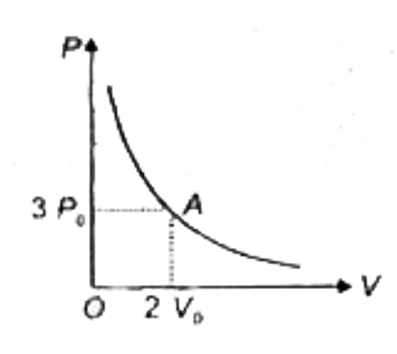 View Solution
View SolutionAn ideal gas having initial pressure P, volume V and temperature T is allowed to expands adiabatically until its volume becomes 5.66V while its temperature falls to T/2.
(i) How many degrees of freedom do the gas molecules have?
Obtain the work done by the gas during the expansion as a function of the initial pressure P and volume V.View SolutionA thermally insulating cylinder has a thermally insulating and frictionless movable partition in the middle, as shown in the figure below. On each side of the partition, there is one mole of an ideal gas , with specific heat at constant volume, Cv=2R. Here, R is the gas constant. Initially, each side has a volume V0 and temperature T0. The left side has an electric heater, which is turned on at very low power to transfer heat Q to the gas on the left side. As a result the partition moves slowly towards the right reducing the right side volume to V02 . Consequently, the gas temperature on the left and the right sides become TL and TR, respectively. Ignore the changes in the temperatures of the cylinder, heater and the partition.
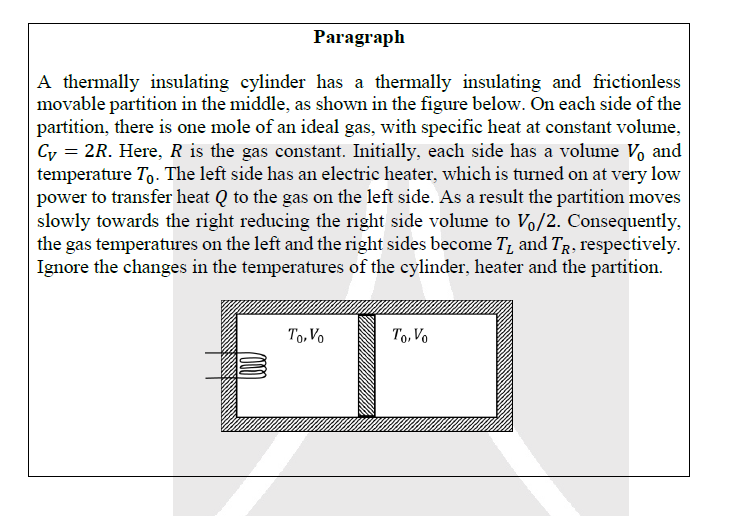
Value of TRT0View SolutionAn ideal gas having initial pressure p, volume V and temperature T is allowed to expand adiabatically until its volume becomes 5.66V, while its temperature falls to T/2.
(a) How many degrees of freedom do the gas molecules have?
(b) Obtain the work done by the gas during the expansion as a function of the initial pressure p and volume V.
Given that (5.66)0.4=2View SolutionAn ideal gas with pressure P, volume V and temperature T is expanded isothermally to a volume 2V and a final pressure P1. The same gas is expanded adiabatically to a volume 2V, the final final pressure is PA. In terms of the ratio of the two specific heats for the gas γ, the ratio PI/PA is
View Solution

